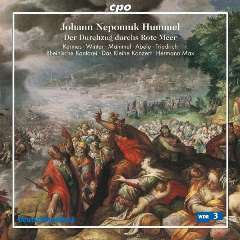Johann Nepomuk Hummel - Der Durchzug durchs Rote Meer (2007)
Johann Nepomuk Hummel - Der Durchzug durchs Rote Meer (2007)

1 Intrada (1. Teil) 2 Chor: Aus der Tiefe unsers Elends 3 Recitativo accompagnato: Und immer schwerer lastet das Joch der Sklaverei 4 Arie und Chor: Ich, euer Väter Gott 5 Fuga: Der Herr hat unser Geschrei erhört 6 Duett: Es macht der Herr durch unsern Mund, dir König, seinen Willen kund 7 Recitativo accompagnato: Verblendet war des Königs Sinn 8 Arie und Chor: Ich schwebe auf des Todes Fittich 9 Recitativo accompagnato: Ein groß Geschrei ging aus (2. Teil) 10 Quartett mit Chor: Der Herr hat unser Trübsal geseh'n 11 Recitativo accompagnato: Sie zogen aus, gewaffnet durch die Wüste 12 Arie und Chor: Und Moses streckte aus die Hand 13 Rezitativ: Es warf das Meer die Toten ans Gestade 14 Chor: Jehova ist ein Kriegesheld Simone Kermes – soprano Veronika Winter - soprano Hans-Jörg Mammel – tenor Ekkehard Abele – bass Wolf Matthias Friedrich – bass Rheinische Kantorei (Choir) Das Kleine Konzert (Orchestra) Hermann Max - conductor
Hummel's oratorio Der Durchzug durchs Rote Meer (The Passage Through the Red Sea) was long thought to have been lost, but a copy has surfaced in a London collection. This is the work's world-premiere recording and perhaps its premiere performance: according to the booklet, it was never performed during Hummel's lifetime. After you hear it, that fact will surprise you; the music has a formal freedom that would lead you to believe that later composers could easily have been familiar with it. The work was probably written in the first part of Hummel's career, when he followed Haydn as music director at Esterháza castle, and it shows the impact of Haydn's late masses, of Die Schöpfung, and of Beethoven's early choral music. However, it has plenty of original ideas, and it doesn't sound much like Hummel's better-known instrumental works. It is quite compact, and its most distinctive feature is flexible text setting that achieves considerable power. The individual numbers are not set pieces for chorus or for one of the five soloists, but intersperse choral and solo passages in a way that suggests music from later in the nineteenth century. Sample the fugue in track 5, which effectively breaks off at its climax for another statement from Moses, the soloist. Hummel's use of recitatives is likewise flexible, with both secco and accompanied passages; the simple recitatives are here accompanied on a fortepiano. The performance is exemplary. The Rheinische Kantorei is one of those regional German choirs whose rich textures demonstrate just how deeply choral singing is embedded in the country's musical and social fabric, and the performance features soprano Simone Kermes among other top-notch soloists. The players of Das kleine Konzert under Hermann Max are both lively and accurate in this live performance, recorded in enough sonic detail to catch everybody taking a breath as the conductor raises his baton, but also to reveal Hummel's attractive textures in full color. Germany's CPO label, which has specialized in unusual works of the Classical and post-Classical periods, has scored one of its most significant releases here. --- James Manheim, Rovi
download: uploaded yandex anonfiles 4shared solidfiles mediafire mega filecloudio nornar








